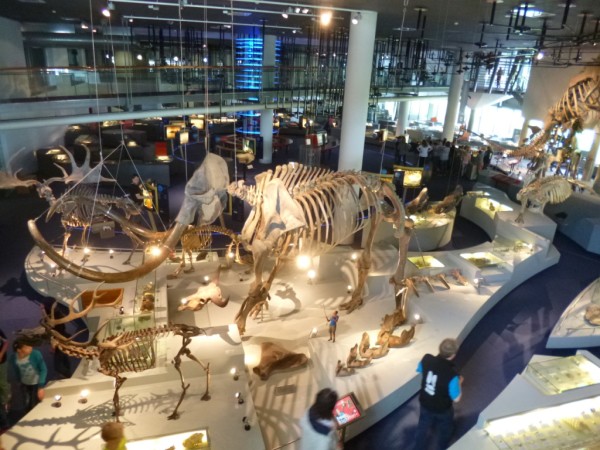This is Part 3 of a four-part series of posts based on the book “Designing for the Museum Visitor Experience” by Tiina Roppola. Go to Part 1. Go to Part 2.
Channelling: the museum visit through space and time
Museum exhibitions can be considered as four-dimensional media – we physically move through them in both space and time. Roppola describes how visitors navigate this trajectory in terms of “channelling”. More than simply wayfinding, channeling describes how “visitors [find] their way through museums conceptually, attentionally, perceptually as well as physically” (Roppola 2012, p. 174). She defines three different types of channels – spatial channels, narrative channels, and multimodal/multimedial channels.
Spatial channels
The most literal interpretation of the channelling concept, spatial channels pertain to the way that visitors ‘read’ museum environments and act accordingly. Some spaces encourage visitors to linger, others chivvy them along. Seating allows time to rest, recharge and ponder. Where seating is provided, it sends visitors a message that lingering is encouraged. Visitors are more likely to sit and watch a video to the end if there’s a place to sit. Conversely, thin galleries may be perceived as corridors and moved through quickly. Doorways and escalators can have a magnetic effect, pulling visitors towards them. But for other visitors, such thresholds may act as a barrier and they hover at the edges rather than enter. In the same way, small enclosed spaces are inviting to some, offputting to others. (In my own research, I’ve noticed how doorways or even just a slight narrowing of gallery can act as a sort of “reset” function– visitors can be seen to act as if they are in a new environment once they’ve crossed that threshold.)
Visitors also vary in the extent to which they want spatial channels to guide them along a certain path – something which emerged in my visitor interviews and which I’ve commented on previously.
Narrative Channels
While spatial channels address the physical movement through an exhibition, narrative channels pertain to the conceptual journey of the visitor. Again, this is something that I’ve been thinking about lately, with respect to my own approach to museum visits. An absence of narrative is often confusing and disconcerting for visitors, but then again not always: it depends on your expectations – do you want to take control or are you happy to go along for the ride? (This brings us back to the concept of Framing which was discussed in Part 1 of this series.)
Without a discernible narrative, an exhibition can be seen as “all mixed up”, “all over the place”, “cluttered”, or having “no real point” (visitors quoted in Roppola, 2012, pp. 204-205). Many visitors described the importance of some kind of theme as a way of organising an exhibition (which will be music to the ears of many interpreters!)
Multimodal/Multimedial Channels
Multimodality is a semiotic concept that encompasses all ways a culture might express meaning. Text, speech, images, gestures and sounds are all examples of semiotic modes. Even fonts and colours can be considered modes in some contexts. Multimodality is thus the integration of multiple modes in the creation of meaning – in a conversation, for instance, meaning is conveyed not just in the words spoken but through tone of voice, gestures and proximity of the speakers. Furthermore, individual modes can be manifested through different media – the mode of text can be communicated through a wide range of media such as a magazine, a scroll of parchment, or an exhibit label.
Multimodal and multimedial channelling thus describes how visitors interact with the different modes and media embodied in museum exhibits. Roppola describes the following:
- Restorative channelling: a diversity of media helps “break up” content, enhancing interest and reducing fatigue associated with reading “panels and panels and panels of text” (visitor quoted in Roppola, 2012, p.190).
- Selective channelling: a way of directing visitor attention. Less is more with selective channeling – a minimalist approach helps to provide a clear focal point to a display. Text hierarchies are also a form of selective channeling by suggesting an order in which to engage with the content.
- Fragmented channelling: caused by too much complexity without sufficient coherence to enable visitors to make sense of it (touching on Kaplan’s theories I’ve described previously – complexity is only pleasant if it’s legible enough for us to make sense of). Fragmented channels can also result from having too large a physical distance between related items (e.g. a label too far away from the object it describes), or having adjacent exhibits competing with each other for visitor attention.
- Synchronous channelling: a harmonious relationship between the multimedial elements of an exhibit. The different parts of the exhibit enhance and complement each other rather than competing for attention. Unlike in fragmented challenging, the complexity of multiple modes and media is complemented by coherence.
One good example of channelling I’ve seen is the “Voices from Eastern State Penitentiary” exhibit (see here). This combined synchronous channelling (the pairing of text, audio and images) and spatial channelling (the sequential positioning of the images along a corridor) help to create a coherent experience through space and time.
Next week – Broadening.
